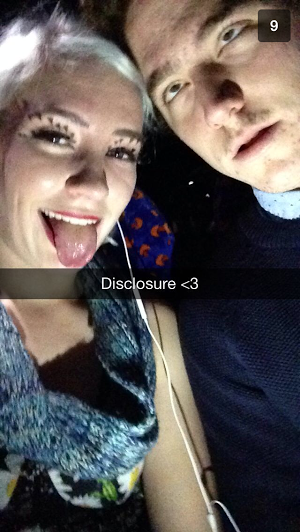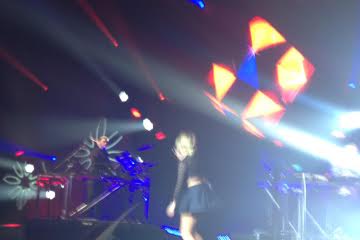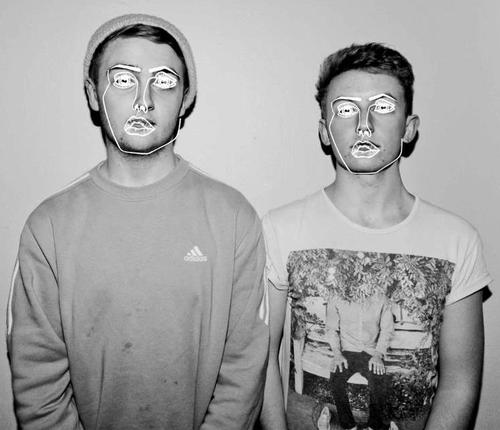The bus from Oxford to London takes about an hour and a half and reminds me of the Knight Bus from Harry Potter: it’s a double-decker bus, piloted by cheeky drivers with English accents, which rescues its passengers from quotidian existence and whisks them off to a place where magic happens in the streets.
My friend Cody and I hopped aboard last Friday, taking a night off from the pubs and clubs that usually color our weekends to answer the call of the bright lights and loud beats that emanate from the city of London.
We had a two-part plan: first, take advantage of the Tate Modern’s late weekend hours to experience the pinnacle of absurdity in the contemporary arts; then, head into south London to see Disclosure perform their signature brand of live dance music at the Brixton Academy. We envisioned the art and music coming together in one harmonious night out on the town - a cosmopolitan evening fit for the twenty-first century.
Looking back, it seems foolish to have expected harmony. It turns out that there is a sharp aesthetic distinction between the kind of art being produced by today’s painters, sculptors, and photographers, and the kind that thumps at 120 beats-per-minute out of subwoofers and into the heads of the ecstatic youth.
In his book The Birth of Tragedy, Friedrich Nietzsche takes two figures from Greek myth to represent two distinct artistic impulses. Apollo, god of the sun, dreams, and reason, stands for the visual arts and the contemplation of dreamlike illusions, while Dionysus, god of wine, ecstasy, and intoxication, personifies music and the primal expression of orgiastic passion. To visit a museum is to worship at the temple of Apollo, considering one painting or statue at a time and appreciating the creative symbolism in each. But to go to a concert - especially one featuring electronic music and its associated orgy of bass, light, and dancing - is to experience an altogether different form of art, for it is “under the charm of the Dionysian” that social distinctions break down, and “each one feels himself not only united, reconciled, and fused with his neighbor, but as one with him.”
I spent the last quarter at Oxford immersed in a study of Nietzsche’s work, and though I know he was writing about the experience of music through symphony and Greek tragedy, I find that his words could just as easily describe a weekend at Coachella, embellished with tribal facepaint, MDMA, and the (albeit diminishing) rave creed of PLUR: Peace, Love, Unity, Respect.
Art has changed a lot since Nietzsche’s time - he was writing before film, Malevich’s “Black Square”, and The Real Housewives of Orange County - but the Apollonian/Dionysian dialectic remains quite useful for understanding why a trip to the modern art museum might not be the best pre-game for a Disclosure concert. Apollo has yet to be completely dethroned at the museum: no matter how abstract or diverse the plastic arts become, they remain united by their drive to represent the world through visual symbols, or otherwise define themselves by the rejection of this principle.
If we had to charge the works of one museum with conspiracy against Apollonian authority in the arts, it would probably be those of the Tate Modern. It is an epicenter for the Young British Artists, that movement whose disheveled beds and formaldehyde-suspended sharks have had critics asking “seriously?” since the nineties. And as Cody and I wound our way through the Structure & Clarity collection, it was difficult to reconcile Piet Mondrian’s colorful geometry or Barbara Hepworth’s sculpted mahogany with any visual reality that we had ever known. By the time we found ourselves in a room whose four walls were occupied almost entirely by canvases from Rothko’s “Black on Maroon” series (I would include a link, but the title really says it all), it was starting to feel like Apollo’s dreams had become our own nightmares. It was a jarring sensation; we were gearing up for hours of gyrating in a sweaty crowd to the songs with titles like “Stimulation,” and there we were face-to-face with Tracey Emin’s “Hate and Power Can Be a Terrible Thing,” a quilt made for Margaret Thatcher which weaves pastel fabrics together with statements like “you have no idea of faith.”
I think Cody said it best when she later remarked that so much of modern art is simply aesthetically unpleasant, often by design. In seeking to defy Apollo but never quite escaping the grasp of the visual, modern art eschews images that can be casually enjoyed in favor of those that provoke, disturb, and unsettle. And unsettled we were. With remarkable consensus, we began to pronounce certain sculptures or even entire rooms to be a “no” when we felt that, say, the documentary about public execution sites in Syria, or perhaps the effigies of human beings hanging from the ceiling in disconcertingly slick, gray cocoons, was not suited for the type of evening we were trying to create.
I certainly think it is important for people to grapple with the difficult truths that can be portrayed in images, whether they be the Apollonian visions of a slumbering dreamer or the revolutionary attempts to shake him awake. But after a long week of academic grind, we weren’t seeking further representation of our world of experience or even defiant rejection of it. What we wanted was a kind of total transcendence and deliverance unto the sensation of primordial unity: the kind of escape that only the Dionysian art of music can offer.
And so Cody and I caught another double-decker bus, this time one of London’s famous red ones, and headed south to Brixton. Around the corner from the venue, we split a fried chicken meal for just four pounds at a small shop called “Tennessee Fried Chicken” (seriously, England?). Our tummies stimulated by the influx of grease, Coca-Cola, and some other essential ingredients for a long night of dancing, we were ready to experience Disclosure.
We made our way to the front of the long line of twenty-somethings clad mostly in black and then through the security checkpoint, past the drug-sniffing dogs, and into the cavernous central hall of the Brixton Academy. We found the stage occupied by some no-name DJ standing before a laptop, bobbing to his selection of lackluster house music as if he expected us to do the same. It was a weak opening act, but I felt at home in the crowd. Having been to more than my share of electronic dance gatherings, I knew that soon enough the headliners would take the stage and their music would dissolve not only my swelling impatience but also some of the deeper anxieties that had been raised back at the Tate. And I knew I wasn’t alone in this expectation: when the two college-aged brothers that comprise Disclosure took their places behind their respective arrays of instruments, the crowd went wild. I prepared myself to be subsumed in the dancing Dionysian mass.
But such a mass did not emerge - at least, not initially. As the band launched into the maddeningly repetitive but oh-so-catchy “When A Fire Starts to Burn,” Cody and I began to writhe like rhythmic animals in our small pocket at the front of the crowd. But as we repeatedly collided with stationary bodies on all sides, it became apparent that our neighbors were not doing the same, obsessed as they were with filming the entirety of the introduction on their smartphones. I looked back expecting to see of a sea of dancing young people and found instead a field of Apple logos superimposed on glass rectangles, all nodding in unison to the simplest beat discernible among the song’s interlocking melodies.
Nietzsche wrote that music alone had the power to break “all the rigid, hostile barriers that necessity, caprice, or ‘impudent convention’ have fixed between us,” but how can I feel any sort of unity with a fellow reveler who spends more time Snapchatting selfies than finding the groove? It has become commonplace for us millennials to disengage from boring situations and disappear into virtual reality, but the phenomenon is more disturbing when set against a backdrop of flashing lights and loud music being played, mixed, and remixed live by two sweating adolescents.

Thankfully, these disturbances did not prevail. As the night went on, iPhones returned to pockets and hands emerged to praise those responsible for the sensual beats coming at us from all sides. I felt the familiar sensation of “letting go,” not just forgetting my worries but reaching a state where such egoistic concerns no longer made sense at all. Cody and I lost ourselves to dance, our moves becoming more and more funky as our bodies felt increasingly fused with those around us. By the time Sam Smith took the stage to sing “Latch” in the show’s finale, the many attendees had become a single, jumping mass, with thousands of feet hitting the floor in unison to fill the gaps between the song’s delicious wobbles.
Things only improved when Disclosure took the stage for a second time to deliver a special DJ set prepared just for London. Those who had come just to hear the hits had departed during the intermission, leaving behind only those of us prepared to hear what happened when the boys stripped off their pop enamel and bared their grimy, garage-y roots. The two hours that ensued were pure ecstasy. With the music as my guide, I traded compliments and dance moves with strangers, made friends with locals, and spent more than a few songs head banging with a longhaired Japanese man from Tokyo.
Disclosure closed the set with a remix that hacked away at the vocals from the Sweeney Todd song “There’s No Place Like London” until all that remained was a metallic robot voice repeating the phrase over and over. I can’t say whether it was the ambiance, the people, or the sheer hypnotic power of the house beat underlying the voice, but something compelled me to believe it.

We thereby reached a cathartic conclusion to a night whose first act - our visit to the Tate Modern - had felt quite discordant. And perhaps by introducing disruption and displeasure into what was otherwise a night of intoxicated revelry, the museum actually asserted its efficacy: Modern Art 1, Cody & Jake 0. Certain images from the Tate stuck in our combined consciousness and became points of contrast for the more ecstatic moments that we experienced at the concert. In this way, the entire night took on a strange duality, with the Apollonian and Dionysian elements simultaneously antagonizing and supporting each other, creating the same sort of twisted union that Nietzsche identified as the apex of artistic creation. The Tate Modern may not have put us in the “right mood” for Disclosure, but it did give a profound coloration to the rest of the evening that I don’t think we could have achieved by any other means. You wouldn’t take your kids to see their grandfather’s grave right before you go to Disneyland… but maybe you should.


